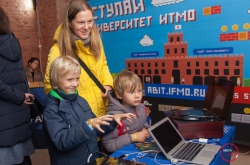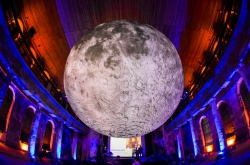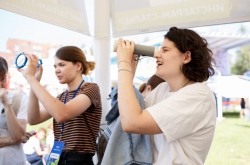Starcon is Russia’s oldest and biggest festival of science fiction, fantasy, film and science. It traces its history to 1999 and is held annually in St. Petersburg since 2012. Originally a convention for Star Wars enthusiasts, these days it features more than 30 fictional universes, booths of many various companies, several dozen science and technology exhibits and a massive science section.

How can sports and VR work together? How do we understand the function of the vital organs and systems of the human body? How can computers learn to understand hand gestures? All this and more can be seen at ITMO University’s booth in the Science section. ITMO University’s Museum of Optics welcomes the visitors to the booth by offering guests a chance to experience human-machine symbiosis and even try to control light.
This can be done using Leap Motion technology which tracks a user’s hand movements. Three infrared sensors analyze hand movements and project them onto a computer screen. Visitors can test several levels of interaction. For instance, one of the possible tasks is catching cubes on the screen using one’s virtual hand and attaching them to heads of robots that appear in the frame.

Here one can also witness a completely new exhibit that demonstrates the stroboscope effect. The device, which has only recently been added to the Museum’s collection, resembles a record player. However, instead of a music record it uses cardboard disks decorated with patterns. A lightbulb hangs above the “player”; the stroboscope effect requires powerful lighting. As the disk revolves, the image loses clarity and cannot be discerned with the human eye; however, if one looks at it through their cellphone camera, it becomes intelligible once again. The effect is quite simple in nature. Human eyes can only see 24 frames per second, so when the image begins to spin too fast, it loses clarity. A cellphone camera, in turn, adapts fast-moving objects for the human eye, which is why the motion becomes smoother when seen through it.

Guests of the festival can also see the robots and drones that are developed by Bachelor’s students at ITMO University’s Department of Computer Science and Control Systems. On the first day of the festival, visitors to ITMO’s booth could try their hand at piloting a quadcopter, which can recognize colors and objects, using a joystick and a laptop. In the future, claim the developers, the drone will also be able to recognize three-dimensional structures.
In yet another section of ITMO’s booth, guests can help repair a spaceship. To work as a mechanic, one needs to complete a VR-quest developed by first-year Master’s students at the Department of Engineering and Computer Graphics. As soon as a player puts on the VR helmet, they are immersed into the role. After “waking up” aboard a space station, players traverse the ship and complete various assignments.

ITMO University’s FabLab has set up a space captain competition. To compete, one has to sign up as a captain and then run the gauntlet against other participants. The tests included a shooting practice and endurance test. For example, competitors have to do pull-ups while keeping a straight face.
Using the interactive Anatomy Handbook, visitors could learn about the functions of the systems and organs of the human body. Using sensor input, they can manipulate an anatomic model of the human body. An interesting feature allows users to “turn off” some of the organs or tissues. For example, one could turn off everything but the bone structure and take a closer look at that part of the body.

Throughout the festival, ITMO students will showcase 3D-printers assembled by OLIMP Laboratory and use them to print cosplay props. On the first day, for instance, they printed a sword, with which they experimented with various printing techniques. Another item printed right at the booth was a precise copy of Darth Vader’s helmet.
At OLIMP, 3D printing isn’t used only for pop culture items – it is also useful for producing textiles. The students demonstrated to the guests how the printer can be used to produce chainmail clothing. Printing clothes is yet another trend in 3D printing; however, developers face the issue of rigidity in such materials and are thus trying to develop a more elastic material. To make it softer, a more flexible type of plastic is used.

Still, staff at OLIMP lab proposes using hard plastic, too. According to them, the right texture can be achieved using composite materials that fuse hard and flexible types of plastic, with the hard type used for the outer layers and the flexible type used for the inside. In addition to clothing, such material can be used to manufacture wallpaper and other objects such as carpets, décor, etc.
Just like at VK Fest, visitors were able to go on a virtual tour using a real bicycle and to apply to university right on the spot.

ITMO University’s section will remain active for the entire duration of the festival. On Saturday, an extensive science program awaits visitors; ITMO University will have its own segment at the Parsec conference of popular science, which is held for the fifth time as part of Starcon. This year’s speakers will include astronauts Gennady Padalka, Mikhail Kornienko, Aleksandr Misurkin and others. Scientists and guest speakers from ITMO University will talk about Big Data and the future of gaming technologies.
What is the modern “invisible” city and how can urban spaces utilize their “strong sides”? How do the myriad variables and different parts of an urban landscape make up the image of a city? This and more will be talked about at a lecture by Damiano Cerrone, co-founder and content manager at Spin Unit.
Alexander Boukhanovsky, head of ITMO University’s School of Translational Information Technologies and of eScience Research Institute, will explain why analysis and visualization of Big Data is a truly innovative field of science and what results we might expect from the development of Big Data in the near future.




